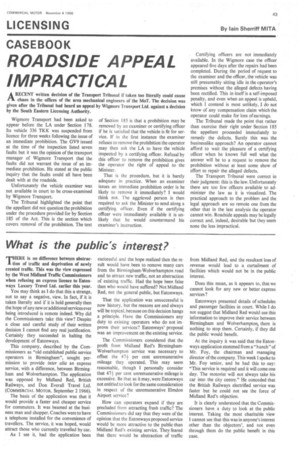CASEBOOK
Page 45

If you've noticed an error in this article please click here to report it so we can fix it.
ROADSIDE APPEAL IMPRACTICAL
LICENSING By lain Sherriff MITA ARECENT written decision of the Transport Tribunal if taken too literally could cause chaos in the offices of the area mechanical engineers of the MoT. The decision was given after the Tribunal had heard an appeal by Wigmore Transport Ltd. against a decision by the South Eastern Licensing Authority.
Wigmore Transport had been asked to appear before the LA under Section 178. Its vehicle 336 TKK was suspended from licence for three weeks following the issue of an immediate prohibition. The GV9 issued at the time of the inspection listed seven faults but it was the opinion of the transport manager of Wigmore Transport that the faults did not warrant the issue of an immediate prohibition. He stated at the public inquiry that the faults could all have been dealt with at the roadside.
Unfortunately the vehicle examiner was not available in court to be cross-examined by Wigmore Transport.
The Tribunal highlighted the point that the appellant did not question the prohibition under the procedure provided for by Section 185 of the Act. This is the section which covers removal of the prohibition. The text
of Section 185 is that a prohibition may be removed by an examiner or certifying officer if he is satisfied that the vehicle is fit for service. If in the first instance the examiner refuses to remove the prohibition the operator may then ask the LA to have the vehicle inspected by a certifying officer. Refusal by this officer to remove the prohibition gives the operator the right of appeal to the Minister.
That is the procedure, but it is barely adequate in practice. When an examiner issues an immediate prohibition order is he likely to remove it immediately? I would think not. The aggrieved person is then required to ask the Minister to send along a certifying officer. Even if the certifying officer were immediately available it is unlikely that he would countermand his examiner's instruction. Certifying officers are not immediately available. In the Wigmore case the officer appeared five days after the repairs had been completed. During the period of request to the examiner and the officer, the vehicle was still presumably sitting idle in the operator's premises without the alleged defects having been rectified. This in itself is a self-imposed penalty, and even when an appeal is upheld, which I contend is most unlikely, I do not know of any compensation claim which the operator could make for loss of earnings.
The Tribunal made the point that rather than exercise their right under Section 185 the appellant proceeded immediately to remedy the defects. Surely this was the businesslike approach? An operator cannot afford to wait the pleasure of a certifying officer when he knows full well what the answer will be to a request to remove the prohibition without at least some show of effort to repair the alleged defects.
The Transport Tribunal were correct in their judgment: this is the law. Unfortunately there are too few officers available to administer the law as it is visualized. The practical approach to the problem and the legal approach are so remote one from the other that in the last analysis the operator cannot win. Roadside appeals may be legally correct and, indeed, desirable but they seem none the less impractical.








































































































































































